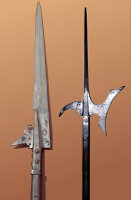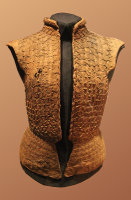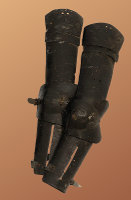The Herefordshire Musters 1539 and 1542
The 1539 county musters were called by Henry VIII’s council in response to a threat of war by France. However the situation eased and the troops were stood down. Then a second muster was called in 1542 when there was military action against Scotland. Herefordshire men may have taken part in the fighting and in the defeat of the Scots at Solway Moss. Of the 2883 men recorded in the Herefordshire 1542 muster, 62 able men over the age of 16 came from Bosbury and Upleadon.
As explained by the Commissioners, the letters stand for: a = archer, b = billman, n = someone providing equipment but not physically fit to fight. The habiliments of war means weapons, armour and sometimes horses and tack.
Arms and Armour




The billman may have carried a bill or billhook which is a short-handled chopping blade used in agriculture. This seems unlikely and here his weapon is called a glaive (a Norman-French word), which possibly refers to a double-handed slashing weapon with single-edged blade around 45 centimetres long attached to a two-metre-long wooden pole. Johnson’s 1755 dictionary has ‘glaive’ as a French word but also an Irish Gaelic broadsword so who knows! It may simply have been a billhook lashed onto a pole but I think my illustration is the more likely. The halberd was a poleaxe with a pike’s point combined with an axe-head and a serious hook on the back of the head to pull horse-riders down. It was most usually carried by guards rather than used in battle. In pole-arms it would seem sensible to make the metal comparatively thin to make the head of the pole lighter and the weapon more easily handled in a fight.
Five pieces of armour are mentioned. A sallet was a light helmet with an outward curve extending over the back of the neck. Some sallets had slitted visors and others were open-faced. A gorget was a metal collar to protect the throat (from gorge in French). A jack was a defensive jacket or doublet made of linen either stuffed with tow, or lined with small metal plates. A splint was a arm protector made of either metal plates fixed on a leather or fabric backing, or forged metal as shown here, held in place by leather straps. Lastly an apron of mail was plates on leather or chain mail worn on the chest.
The full harness for an infantryman or archer would consist of sallet, gorget, pair of splints and jack which would protect most of the upper body. Making this equipment would be the work of a professional armourer and it is unlikely that a village blacksmith would have the necessary skills.
1539
Source ref. TNA E36/31, p1
Book ref. Page 2
From the King in Council, 1 March 1538/1539
![]() Henricus octavus dei gra Angl & franc Rex fidei
defensor dominus Hibn & tra supm caput Anglicane eccl dilcis & fidelb suiis Walto Dno Ferrors, Edwardo Croft milit ....
Henricus octavus dei gra Angl & franc Rex fidei
defensor dominus Hibn & tra supm caput Anglicane eccl dilcis & fidelb suiis Walto Dno Ferrors, Edwardo Croft milit ....
Henry VIII by the grace of God King of England & France, Defender of the Faith, Lord of Ireland and on earth Supreme Head of
The Church of England to his beloved and faithful Walter Lord Ferrors, Sir Edward Croft, Sir James Baskervyle, Sir Richard Vaughan,
Sir William Thomas, John Scudamore, John Russell, James Vaughan, Thomas Monyngton, Thomas Baskervyle, Rowland Morton, Miles ap Harry,
Richard Walewyn, Nicholas Fytton, Richard Palmer. Richard Warmecombe, Thomas Havard, John Beryton, Nicholas Chyppenham & Rowland
Brigge & the sheriff for the time being. Greeting: Know that we, by the advice of our Council, fully confident of your faithfulness,
prudence and circumspection, have assigned to you & two of you (as) our commissioners and deputies giving an granting you by [this]
present full power and authority jointly & severally to array, inspect, examine and so to arrange to be armed and armoured all
and singular men at arms, armed men capable of arms both archers and other men horseman and foot-soldiers over the age of 16 years
in every place in the county of Hereford being within the liberties and outside .. and to have arms and armour in proportion to their
capacities according to the form and effect of statutes and ordinances before these times thereof issued & provided. And diligently
to arrange and oversee the duty, muster or inspection of our same subjects and their arms & armour. So that the same men at arms
and armed men and archers and other aforesaid fencible men thus armed, equipped, inspected and armoured henceforth from time to time
may be exhibited and prepared to serve us as and when there is need and necessity, we have assigned, as stated above, you and two
of you mutually to inspect, examine and array all and singular of you likewise and to arrange to be ordered for using and seeing
with arms and equipped horses & in the aforesaid manner so that the men and each of you may be exhibited inspected, arrayed and
made ready in the aforesaid manner & continuously equipped to serve us likewise as is aforesaid.
And so we order you that you shall diligently attend to the above matters on certain days and at certain places [on] which you shall
see to this being done and carried out reasonably according to sound discretion and in the aforesaid manner. We give moreover to all
and singular our officers, ministers and subjects whatsoever within the liberties and without by the tenor of [this] present firmly
in commands to you that in the execution of these premises they may be equally well-directed, well-advised & diligently obedient
in all things. And which you will do in the premises together with the names and surnames and number of horsemen, foot-soldiers &
archers & of all arms & other armour because by you in the aforesaid manner of inspected and armed men in each place within
the aforesaid county in which they dwell and of the diversity of arms to which of every single one of them is armed, we and our
Council on Easter Day net in one month under your seals or those two of you will duly certify. In witness of which we have caused to
be made these our letters patent. Witnessed by me in person at Westminster. First of March in the 30th year of King Henry [1538/9]
.... debite ctificetis. In cuius ret testimoniu has leras nras fieri fecms patentes. Tbme ipso apud Westm primo die Martii anno r H tricesimo.
![]()
Book ref. Page 4
Reply from the Commissioners
![]() To the king, our sovereign lord: certify your highness
and your most honourable council your faithful and obedient subjects Sir Edward Croft, Sir James Baskerville, Sir Richard
Vaughan knights, John Scudamore, Thomas Monington, James Vaughan, Richard Wallwyn, Miles ap Harry, Thomas Baskerville, Nicholas
Fytton, Richard Palmer, [Nicholas Chippenham,] Richard Warmcombe & Thomas Havard that immediately on the receipt of your high
commission, hereunto annexed, to use among others in the same commission also named for the mustering & putting in a readiness
with habiliments of war of all & singular your subjects commorant & abiding in your county of Hereford that we, the said
commissioners, assembled ourselves together at the city of Hereford where we then separated & alloted ourselves by two at the
least to the several hundreds of the said shire as before is expressed for the true and effectual execution of the same your high
commission and have mustered all and singular your subjects there accordingly and, by this present book of our certificate, certify
your majesty and your said honourable council as well the number of able men for the wars as well as archers as billmen as the
certent of all habiliments of war and for the trial of archers from billmen. We have written in the margin of this our book
over the head of every archer this letter ‘a’ & over the head of every billman this letter ‘b’ &
also after every surname of every of them have declared the habiliment of war which every of your said subjects as be not able
persons for the wars and having habiliments of war we have marked with this letter ‘n’ and all [other] your poor subjects
of the said shire not meet for the war and being of no ability to have habiliments of war, we have clearly omitted out of this
book referring them to pray to Almighty God for your most royal estate long time prosperously and joyously tender.
To the king, our sovereign lord: certify your highness
and your most honourable council your faithful and obedient subjects Sir Edward Croft, Sir James Baskerville, Sir Richard
Vaughan knights, John Scudamore, Thomas Monington, James Vaughan, Richard Wallwyn, Miles ap Harry, Thomas Baskerville, Nicholas
Fytton, Richard Palmer, [Nicholas Chippenham,] Richard Warmcombe & Thomas Havard that immediately on the receipt of your high
commission, hereunto annexed, to use among others in the same commission also named for the mustering & putting in a readiness
with habiliments of war of all & singular your subjects commorant & abiding in your county of Hereford that we, the said
commissioners, assembled ourselves together at the city of Hereford where we then separated & alloted ourselves by two at the
least to the several hundreds of the said shire as before is expressed for the true and effectual execution of the same your high
commission and have mustered all and singular your subjects there accordingly and, by this present book of our certificate, certify
your majesty and your said honourable council as well the number of able men for the wars as well as archers as billmen as the
certent of all habiliments of war and for the trial of archers from billmen. We have written in the margin of this our book
over the head of every archer this letter ‘a’ & over the head of every billman this letter ‘b’ &
also after every surname of every of them have declared the habiliment of war which every of your said subjects as be not able
persons for the wars and having habiliments of war we have marked with this letter ‘n’ and all [other] your poor subjects
of the said shire not meet for the war and being of no ability to have habiliments of war, we have clearly omitted out of this
book referring them to pray to Almighty God for your most royal estate long time prosperously and joyously tender. ![]()
1542
Book ref. Page 53
From the Commissioners, 16 September 1542
![]() The Hundred of Radlow. the names of able men as were mustered at Ledbury dwelling
within the Hundred of Radlow the 19th day of September within the 34th year of our
said sovereign lord [1542] before John Scudamore, Richard Warmecombe, Stephen ap
Harry and Roger Bodenham esquires within the allotment of the said John Scudamore
and Stephen ap Harry by virtue of the kings majesty’s commission &c.
And also the names of such persons as are appointed to find harness and other
habiliments meet for the war &c.
The Hundred of Radlow. the names of able men as were mustered at Ledbury dwelling
within the Hundred of Radlow the 19th day of September within the 34th year of our
said sovereign lord [1542] before John Scudamore, Richard Warmecombe, Stephen ap
Harry and Roger Bodenham esquires within the allotment of the said John Scudamore
and Stephen ap Harry by virtue of the kings majesty’s commission &c.
And also the names of such persons as are appointed to find harness and other
habiliments meet for the war &c. ![]()